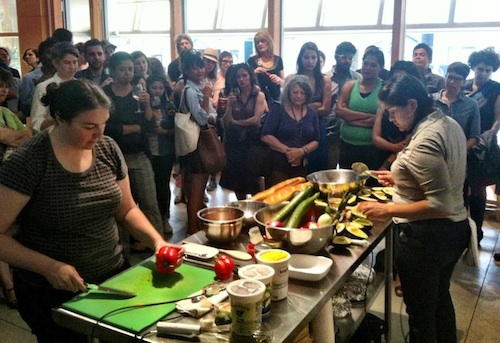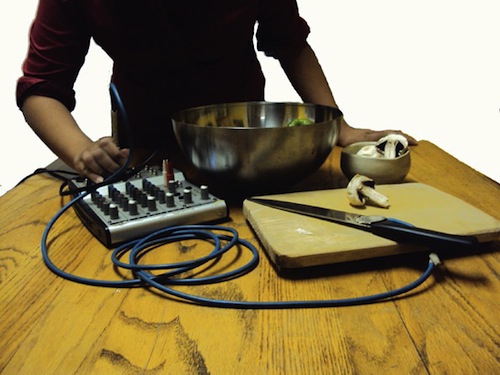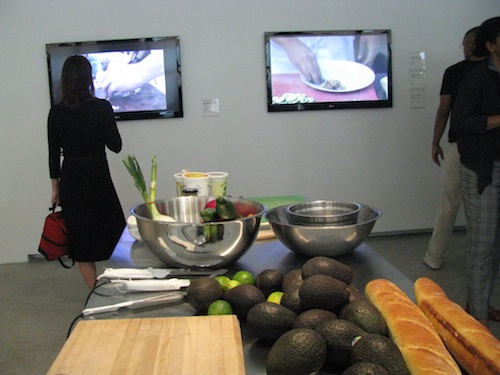Toronto resident Lisa Myers is like many cultural workers in that she wears a few different creative hats: artist, curator, writer, and musician. What is maybe atypical is that she’s also a chef. At first, Myers cooked to make a living while she sang and played guitar in bands and also studied new media. She eventually decided to obtain, in addition to other college credentials, a diploma in culinary arts. Myers had kept her various jobs and interests “kind of separate.” Then, a few years ago, all of her pursuits began to merge. The following video, Jimmie Durham’s Quick Biscuits, is a perfect example.
Quick Biscuits is a collaboration between Myers and New Mexico-based writer and performance artist Autumn Chacon. The women met earlier this year while in residence at Canada’s distinguished Banff Centre. Chacon, who conceived of the piece, directed and recorded Myers as she “performed” the biscuit recipe. Chacon gives us an intimate view into the bowl, but the emphasis here is not so much on the look of the ingredients as the sound of them. Contact microphones attached to Myers’ cooking utensils amplify every pour, stir, scrape and pummel of flour, baking soda, salt, and yogurt. For Myers, Quick Biscuits is like a concert: “The recipe is the score. The cook is the musician. The foods are the instruments. And then the implements—the knives, the bowls, the whisks, the peelers—act as microphones.” For me, Quick Biscuits is worse than a Skrillex track. Of course, I have taste for certain sounds like I have tastes for certain foods.

“Noise Cooking” performance. Lisa Myers (left) and Autumn Chacon (right). Courtesy of Art Gallery of Ontario.
“One of the objectives here is to convey the experience of the food,” Myers said during a recent Skype call. “Somehow, through the sound, you can hear what is happening in that process of making food and what is happening for the food itself.” Listening to it makes me feel as bad for biscuits as I do for factory-farmed chickens—what a dreadful experience. Myers seems tickled by reactions like mine. When she and Chacon performed live for the opening of their sound and video show Noise Cooking, now on view at Art Gallery of Ontario, they sent some visitors scurrying. They sliced breads, cut avocados and mixed salads while manipulating the sounds from their utensils through guitar effects pedals. “It was pretty loud,” Myers proudly recalled. “It caused…quite a cacophony.”
Whether she’s cooking food or composing music, Myers has a propensity for improvisation, taking chances and tossing in the unexpected. She says of making Noise Cooking, “We wanted to add to this idea of sound art”—a genre nearly synonymous with the name John Cage. In this centennial year of the composer’s birth, lots of writers are reminding us why he’s been dubbed “the father of musical invention” or “the father of noise.” Cage upended people’s expectations of music, performance and art. He privileged live experimentation over a set score, and created works free of restraint and full of playfulness. He rigged piano strings with screws and bolts. He used ice cubes, an electric mixer, and a bottle of wine as instruments. He loved chance sounds. Also, he loved to cook. Cage’s kitchen was one stage among the many that he played in his lifetime. In his video 27 Sounds Manufactured in the Kitchen everyday actions—washing vegetables, cracking pepper, and opening lids—give way to a sort of jangled symphony. Cage, I think, would have dug Noise Cooking.
Myers and Chacon set the mood for Noise Cooking by turning Art Gallery of Ontario’s first-floor space into a quasi prep kitchen complete with a stainless steel chef’s table. Visitors can order snacks and drinks here and partake of them in situ. In so doing, they “add to the soundtrack of the room.” Microphones underneath the table capture ambient noise that is then amplified in real time. Three monitors in the room play Quick Biscuits along with eight other videos of collaborative cooking performances that Myers and Chacon have since developed together or with other artists. Fittingly, the show can be accessed through the AGO’s Frank Restaurant (named for its designer Frank Gehry), which Myers describes as an “upscale modern cuisine” kind of eatery that uses “local, regional foods.” Frank chefs Sonny Bou, Sarah Albuquerque, and Ze Ji Lin were invited to guest star in the exhibition; three videos show their interpretations of, among other recipes, Lisa Myers’ Blueberry Skaan (Bannock) and Autumn Chacon’s Fry Bread.
“The recipes we chose mean home to us, they remind us of someone, or they were passed down from our grandmothers,” says Myers. Noise Cooking is not only about the personal and familial but also, naturally, the cultural implications of foods. For instance, Bannock and Fry Bread both are also known as “Indian bread,” a name given to signify the recipe’s association with indigenous cultures of North America. Myers is of Ojibway descent. Chacon is Navajo.“There is this colonial strain [in the installation], says Myers. “And it holds so much history about where we are and what’s gone on in Canada. Not everyone thinks about those political implications. I think it’s really interesting that foods can pull in all these threads–if you really want to get into it. As an artist, curator and researcher thinking about all of these things, I did.”
Cultural politics get heavier treatment in Myers’ upcoming project for Toronto’s annual event Nuit Blanche. For this Myers has organized Night Kitchen, an immersive and interactive installation that likens the act of processing people through an institution to food passing through the digestive system. In this case, the viewers are the meal; they enter at one end and exit through another. The course begins with Treaty Card, an ongoing web project by Cheryl L’Hirondelle that “addresses relations between natives and non-natives by re-examining the intent, issue and details of the Canadian Government’s ‘Certificate of Indian Status.'” Every participant will receive a status card bearing an upside-down Canadian flag. They’ll also receive a digestive cookie. Myers says that although Night Kitchen is “complicated” and “raises issues around treaty relations,” the installation is meant to be “kind of tongue-in-cheek and fun.” Profound and humorous. How Cage-ian.
Noise Cooking is on view at the Art Gallery of Ontario through October 28. Nuit Blanche takes place September 29 from 7:03pm until sunrise.






Pingback: Supersonic (After Cage) | Nicole J Caruth